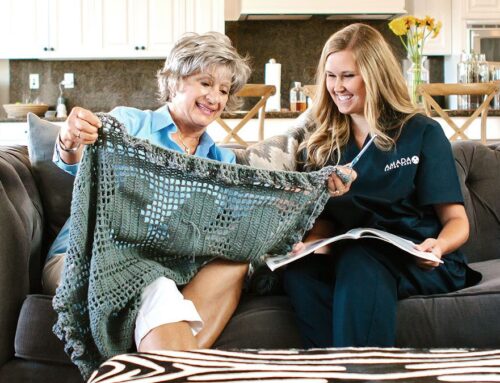If you are over a certain age, you may remember the trials and tribulations of George Jetson, the beleaguered head of household on the popular futuristic 1960s cartoon The Jetsons. Set in Orbit City in 2062, every Saturday morning you and your bowl of Cocoa Pops likely perched in front of the TV, watching George, wife Jane, daughter Judy, and son Elroy navigate their flying car and pneumatic tube transport system. You marveled at their televiewer, the food-o-mat enabling them to push a button to prepare meals and chuckled when Rosie the robot housemaid (an early incarnation of AI) went into overdrive.
While the entertainment value was there, as the saying goes the future is now and in one form or another, much of this has come to pass. Though we’re not yet flying out for ice cream, giant leaps in technology routinely make life on earth easier—largely for seniors.
The Rise of Telehealth Technology
But first, contrary to popular thought, though not born with a keyboard in their hands like their Millennial and Gen Z counterparts, studies show many seniors want to use technology. Beyond email, Facebook, Alexa and Facetime, seniors are embracing options that include telehealth platforms like Teledoc, in part fueled by the pandemic and a lifeline for frail, susceptible, and limited mobility seniors. In the realm of decreasing isolation and depression are entities like Papa, an online service with a network of trained people to provide support and companionship, and the aptly named line of robot roommates or digital companions including ElliQ: a desktop robot designed to engage in friendly conversation and also summon help from a programmed list of resources if necessary. Even in exercise, stationary bikes and treadmills with the most advanced monitors can also provide exercise and mental stimulation for seniors.
Successful Aging Going Robotic?
Gerontechnology, a field focusing on the interaction between seniors and existing and developing technologies, was created to facilitate “successful” aging, as its billing goes. Wearable devices to monitor changing health conditions, track the gait of dementia patients or other seniors experiencing physical decline to assess fall risks, or improve physical activity overall are just a few of the many positive byproducts of gerontechnology. Projections are that robots designed to facilitate activities of daily living—ADLs—including bathing and dressing will become an integral component of care services in the not-too-distant future.
Personal Emergency Response Systems Come of Age
Among the most recognizable ad campaigns of the 1980s and ‘90s is the one with the familiar battle cry, “I’ve fallen, and I can’t get up,” making an emergency response pendant called LifeLine™ a household name. (The catchphrase was later registered to LifeAlert™, as “Help, I’ve fallen, and I can’t get up.”) While parodied to this day, according to the Centers for Disease Control (CDC), approximately 36 million falls are reported among older adults each year. Of this number, 3 million are treated in emergency rooms, 300,000 hospitalized for hip fractures, and 32,000 individuals die.
While fall prevention is the goal in the first place, according to U.S.News.com major strides in medical alert systems include Get Safe, One Call Alert and Life Protect 24/7 which offer a variety of emergency assistance options in the form of pendants; wall buttons; and landline, cell-based, and GPS systems. Similarly, home care agencies like Amada Senior Care offer PERS devices that supplement the services of an in-home caregiver. Amada Connect is designed to summon a first responder in the event of a senior fall or other emergency.
High-Tech Medication Monitoring
Because some measure of cognitive and visual decline is imminent as we age, older adults run the risk of forgetting to take medication, overdosing, or mixing up pills. In the past, medication management was left up to the little pink (or blue) plastic pill box, which did little more than separate meds and did a perfunctory job at best. Enter current technology such as the Hero Health automated pill dispenser, a smart tool that holds up to 90 days’ worth of 10 medications, comes with an app, allows for remote (caregiver) medication management if the senior is unable to manage technology, provides pill alerts, a refill delivery service, and more.
Preserving Legacy via Interactive Technology
In 2021, Dimensions in Testimony added another layer to the painstaking work of the USC Shoah Foundation, initiated in 1994 by director Stephen Spielberg as the Shoah Foundation. One year after filming Schindler’s List, Spielberg set out to conduct thousands of audio-video interviews with aging Holocaust survivors whose numbers were dwindling. When Dimensions in Testimony stepped in, prerecording interviews addressing hundreds of questions with the even fewer remaining survivors, the technology enabled real-time responses to questions from students, museum goers, and others whose opportunity to interact will form an evergreen link with a dying epoch in history. In fact, the survivor appears as a hologram of sorts on a stage, creating a true audience experience.
What may even more compelling about this particular technology is its capacity to preserve our legacy long after we are gone. Imagine grandchildren, great children, and the generations that follow able to interact with us in nearly a one-on-one basis, giving new meaning to the words lasting memories.
The Impact of the Metaverse on Aging
Revealing a world—or metaverse—where a set of interconnected digital spaces lets you do what you cannot do in the physical world, Facebook (now called Meta) founder Mark Zuckerberg and others are opening the door to improved aging. Though the goal to connect in this way extends far beyond senior care, the metaverse will provide the feeling of standing or sitting beside another individual, whether a family member, caregiver, physician, or others anywhere in the world. If you need to see a specialist in Switzerland, a close physical exam can likely be conducted from your bedroom. If you are housebound with grandchildren hundreds of miles away, you can be in the kitchen with them for lunch or by the tree on Christmas morning. And what about attending a concert in Austria by the Vienna Philharmonic. Metaverse tickets, anyone? In short, pandemic-related quarantines, and reducing social isolation in older adults—a significant issue in healthy aging, can be relegated to the pages of history.
While parts of the metaverse already exist in the form of videogames and virtual reality devices, technology has a long way to go before reaching the ultimate goal of lifelike avatars at our weddings and Thanksgiving tables. But inconceivable as it all seems, here it comes.
To paraphrase the immortal words of George Jetson as he walked atop a warp-speed human conveyor belt, “Jane, don’t stop this crazy thing!”
“Ways New Technology Will Benefit Senior Aging and Health,” written by Beth Herman, Amada blog contributor.



